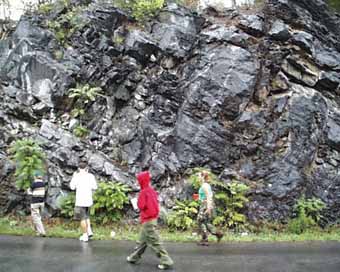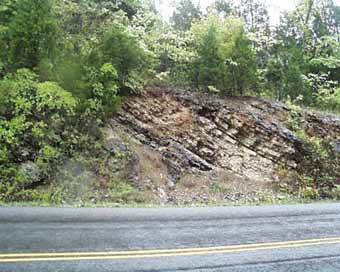
STOP 8 - TRIP ONE
( Next Stop) ( Previous Stop) ( Index Map) ( Trip 1 Home) ( Trip 2 Home)
Tumbling Run Section - Ordovician
New Market, Lincolnshire, Edinburg
Geology 364 - Stratigraphy and Basin Analysis
Dept. of Geology and Environmental Studies
James Madison University
Lynn S. Fichter

 Drawing of outcrop with location of numbered pictures. Drawing of outcrop with location of numbered pictures.
The Tumbling Run section is a long section, and includes the Beekmantown, New Markte, Lincolnshire, Edinburg, Oranda, and Martinsburg formations. Here we see only a small fraction of the total.
The top picture (#29) is the New Market at the east end of the bridge over Tumbling Run creek. We see only the top of the formation. It is a very pure bird's eye micrite, with a notably light gray color on both weathered and broken surfaces. There are also present ostracods and the coral "Tetradium."
The right picture (#30) is the New Market-Lincolnshire contact, with the biosparite beach, black, evenly bedded micrite lagoon, and beginning of the reef.
|
 Right picture (#34) is farther down the outcrop well into the storm shelf system. They are mostly dark gray micrites interbedded with bioclastic micrites. Some zones have abundant spherical, concentric layered calcareous algae.
Right picture (#34) is farther down the outcrop well into the storm shelf system. They are mostly dark gray micrites interbedded with bioclastic micrites. Some zones have abundant spherical, concentric layered calcareous algae.
|
 Right picture (#41) is the first zone of cobbly weathering. It is interbedded shales and micrites. The micrites are all loaded into the underlying shales, indicating they were transported in via some mass transport mechanism, probably a turbidity current.
Right picture (#41) is the first zone of cobbly weathering. It is interbedded shales and micrites. The micrites are all loaded into the underlying shales, indicating they were transported in via some mass transport mechanism, probably a turbidity current.
We argued here that this is the first evidence that the shelf has begin to sink into a foreland basin. Can you reconstruct that argument?
|
 Right picture (#43) is farther down the outcrop than we ventured. It is another zone of cobbly weathering, although it is not due to loading. Instead it is a weathering phenomena. In the interbedded micrite and shale the shale weathers easily, and begins to crumble. The micrite, however, is tougher, and is jointed. Water seeping in along the joints starts to dissolve the micrite resulting is a rounded shape; the cobble.
Right picture (#43) is farther down the outcrop than we ventured. It is another zone of cobbly weathering, although it is not due to loading. Instead it is a weathering phenomena. In the interbedded micrite and shale the shale weathers easily, and begins to crumble. The micrite, however, is tougher, and is jointed. Water seeping in along the joints starts to dissolve the micrite resulting is a rounded shape; the cobble.
Down through this part of the section shale and micrite vie for dominance; sometimes the beds are mostly shale, sometimes mostly micrite, sometimes alternating. Soon (up section) it will change into the Martinsburg formation, and eventually become a feldspathic-lithic rich turbidite deposit.
|
|


 Right picture (
Right picture ( Right picture (
Right picture ( Right picture (
Right picture (